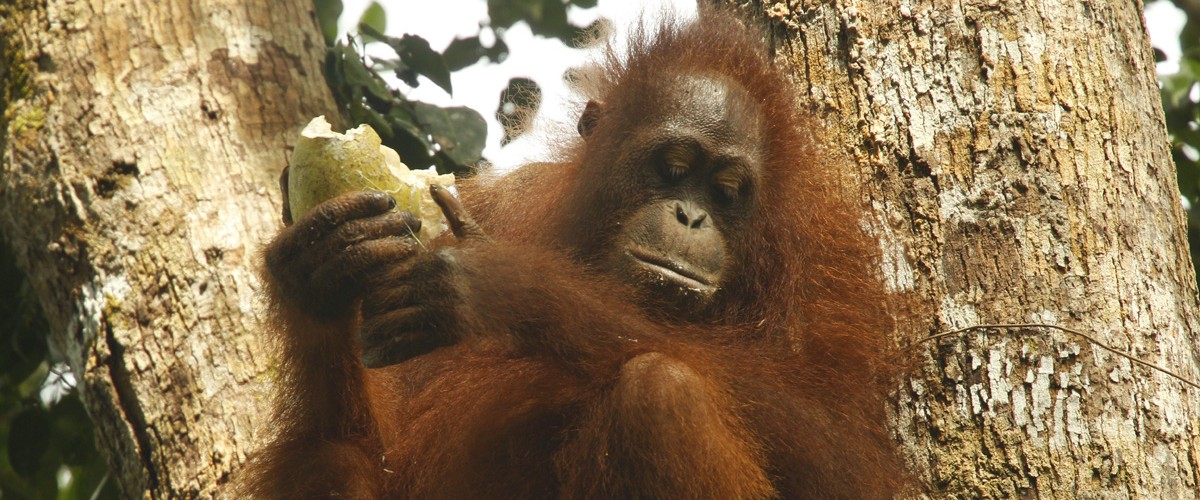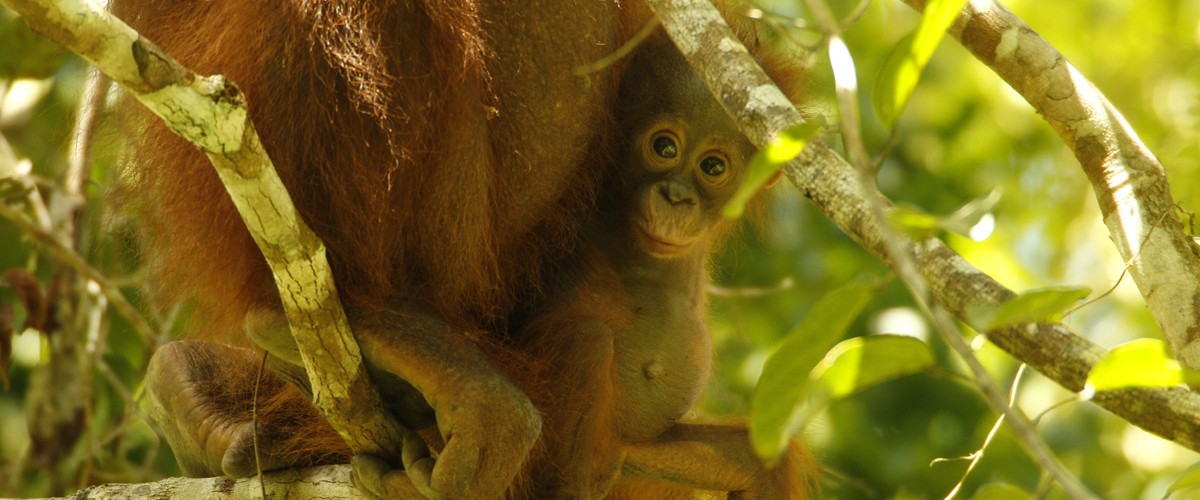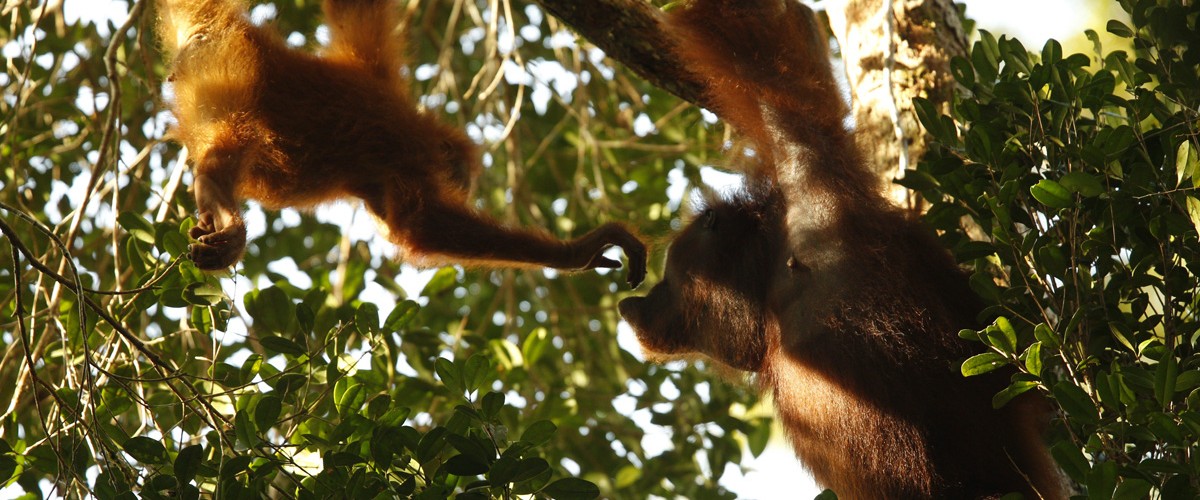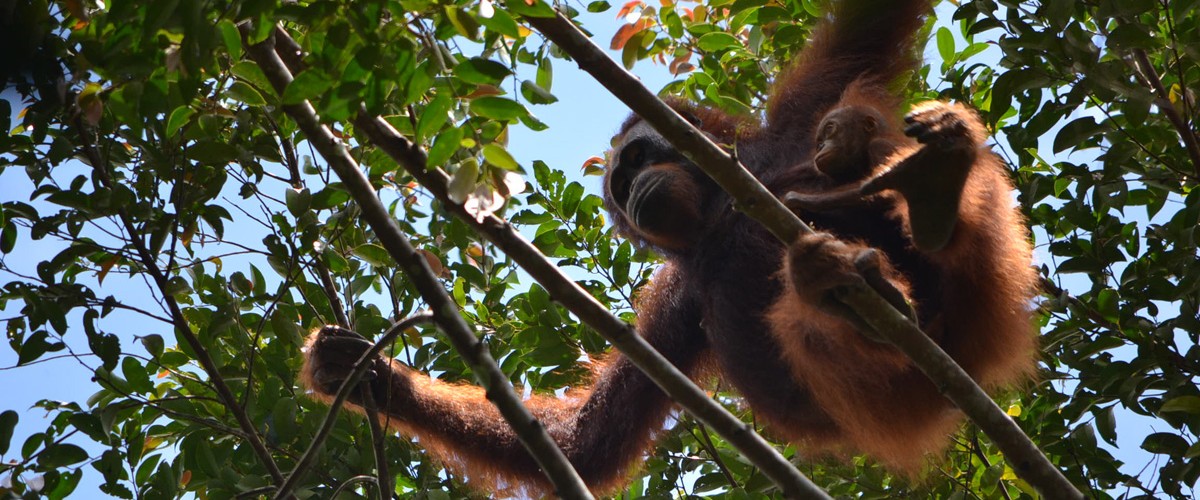By Cheryl Knott, GPOCP Executive Director
It’s dark now and Walimah has finally made her nest and gone to bed. Hassan and Sahril are giving the tree an aluminum tag with the number 79589. It’s hard to believe that the study site has that many tagged trees – most of them representing where an orangutan ate or slept. Using headlamps to see, we measure the tree’s diameter and then tie a biodegradable string to the tag. Our GPS units tell us where the nearest trail is, and we start bushwacking our way through the forest, trying not to trip on the roots emerging from the swamp water and avoiding the snarls of rattan vines that catch our clothing and hair. My graduate student, Andrea Blackburn, and I look for small bits of protruding earth, or at least shallower water, to place our next step. Hassan has been leading the string out as we slowly make our way out of the swamp. When we finally reach the trail, he ties the string off across it and attaches a bit of flagging. The next morning a new team will use this as their guide to get to the orangutan’s nest before dawn. Once on the trail, we follow the path back another 40 minutes to camp, looking forward to washing the dirt off by jumping in our glorious river when we return.

|
| Walimah, moving along to her next rainforest meal. |
And so ends another day of following wild orangutans. I’m thrilled to be back in the forest and spending time with my team – clarifying questions, reviewing our procedures and being in the thick of it again. I spent much of August in the field, visiting the research and conservation projects with my family – Tim, Russell and Jessica. Although our visits never seem to last as long as we would like, we were sure lucky in the number of orangutans we saw. The staff seem to think the orangutans know when ‘Ibu Cheryl’ has come back. We were particularly eager to encounter Walimah and see how her foot was healing. It was thus a special delight when she was found just a few days before the end of our visit. Because orangutans have such big home ranges, we can’t really go out and find a particular individual – we just have to hope we get lucky – although we do use a bit of detective work to track them down. Amazingly, Walimah’s foot looks totally healed. The skin is no longer puffy and, surprisingly, she is able to use her two remaining toes to help grasp branches. She doesn’t seem to be able to use them to form a tight grip, though, but this is a vast improvement over last summer when they were just useless, non-functioning appendages.

|
| Walimah displays her healed left foot, with two toes missing and a chunk bitten out of the side. |
The next day after my adventure in the swamp, Andrea and I are joined by the rest of my family. Robert Rodriguez Suro, my former student and volunteer, who has just spent the year conducting as many multi-day follows as he can of males by camping out in the forest with them, accompanies us as well. You never know what a day following orangutans will bring. Often, it’s fairly routine: they get up, travel, eat, travel, eat, travel …. But, then, sometimes, something amazing happens. This was to be one of those days. The orangutans were again in this particularly nasty bit of freshwater swamp all day. We had two teams out, one following Walimah and the other following Beth and her six-year-old juvenile, Benny. Beth is looking pretty old now and I can’t help but remember our week long, all day follows of her back in 1995 when she was pregnant with her first baby. One of those epic days was recorded in my first National Geographic article back in 1998. I started that piece by quoting Tim, who, as we waded neck deep in the floodwaters that had risen up on our way home, turned around to say to me, “are we in Borneo or what?” This is another “are we in Borneo or what” spot. With every step I take my rubber boot gets stuck in the mud and I have to reach down and yank it out. Sometimes my momentum carries me forward and I keep going, sinking my socked foot into the muck as my boot stays entrenched in the mud. And, I have to admit to doing a full body plant in the swamp more than once.

|
|
Jessica Laman follows an orangutan while knee deep in the Gunung Palung freshwater swamp.
|
The follow starts out to be pretty routine – one of those where the orangutans are feeding 30m up in the top of a tree for hours. Using our binoculars we can barely see a bit of orange fur, but we keep track of their feeding by listening and counting the falling fruit husks that litter the area around us. Eventually, someone hears a rustling in the understory – and we know by the sound that it’s another orangutan. Could this be a male traveling low? We head over to the noise, and sure enough, it’s Alfred, the new dominant male in the study population.
|
|
|
The new dominant flanged male in our study site, Alfred, pauses after feeding on a snack of leaves. Photo by Russell Laman.
|
He’s a magnificent animal and amazingly habituated. He could care less about the big party of humans looking at him as he continues feeding on the low lying vegetation. Standing just a few meters away, this is the closest I’ve ever come, in over 20 years of research, to a wild orangutan. Rarely do orangutans feed so low down that we can see them this clearly. He doesn’t even look at us, but seems oblivious to our presence – the way we want it to be. Then, he starts moving towards the females we’ve been following. Undoubtedly, this is what has led him to this isolated bit of swamp forest. He races up a tree and pushes over the top part of a tree snag. After it comes crashing down he lets out a magnificent long call, letting all know that he has arrived. Alfred puts on quite a display, continuing to crash around and long calling several times for the benefit of all in earshot. Then, to our surprise, he starts chasing Beth and they spend over 10 minutes mating. This is the clearest view of mating that any of us have ever had. Of course, Tim and Robert have captured it on videotape. What a way to spend our last day in the field this year! And, maybe next year we will be following Beth around with a brand new baby.

|
|
Russell Laman, Cheryl Knott and Jessica Laman get an up close view of Alfred foraging on low lying vegetation.
|









